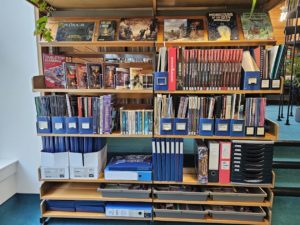NOTE: Please read the Guidelines and Expectations document which also includes Table Rules.
You will need: yourself, your imagination, pencil and paper or notebook (for keeping your own track of adventures).
The school library provides polyhedral dice sets for your use and can provide pre-made characters or the Librarian will help you create your own character. NB. This can take some time and you would need to come in at lunchtimes to do this so that during activities time we can get on with playing. Pre-generated characters can also be provided which are usually from the D&D website. Check out the Links & Useful Documents below for guides and blank character sheets.
 5e Core Rulebooks are available in the library but are only available for short term loan as they are needed in school on a Tuesday, Thursday and Friday. These include: Player’s Handbook; Monster Manual; and Dungeon Master’s Guide, published by Wizards of the Coast in 2014.
5e Core Rulebooks are available in the library but are only available for short term loan as they are needed in school on a Tuesday, Thursday and Friday. These include: Player’s Handbook; Monster Manual; and Dungeon Master’s Guide, published by Wizards of the Coast in 2014.
Generous donations in 2018 now mean that there are more core D&D 5e rule books and adventure modules available, which can now be borrowed to take home. See Donations.
There is also one set of 4th edition manuals available for use and for short loan as well as a 3.5e Players Handbook and Monster Manual.

If you are keen, it is highly recommended you purchase your own copy of the Player’s Handbook* and a set of D20 dice. Basic rules can be downloaded from the D&D website.
*NB. We are now mainly using 5th edition. Consult with Mrs Sinclair before purchasing your own manuals.
You can play a variety of different race and class combinations (from Player’s Handbook):
- Classes – fighter; wizard; cleric; rogue; ranger; barbarian; bard; druid; monk
- Races – human; elf; dwarf; halfling; gnome; half-orc; tiefling; dragonborn
There are also further race and class options in other D&D books such as Volo’s Guide to Monsters, including some monstrous races, Xanathar’s Guide to Everything, both available in the library. There are also other race, subrace and background options in other official D&D books and adventure modules published by Wizards of the Coast.
IMPORTANT NOTES
- It is up to your Dungeon Master as to what race and class options they will accept in their games. Often, especially if they are using a homebrew setting of their creation, there might be some limits set. Discuss your options with your DM. Unless you have your own source books, it is best to stick with the options available to you in the books that are in the school library. Mrs Sinclair’s guidelines on character creation are included in the Guidelines and Expectations document.
- Copyright: There are no official PDFs of the printed hardback D&D books published by Wizards of the Coast. Any you happen upon on the internet are illegal. Please DO NOT use them, let alone pay someone for them, or bring copies into the school! Digital versions are available to purchase via DnDBeyond which you can sign up to if you are 13 years or over (ask for parental permission, please).
The key to D &D is role playing, where you play an imaginary character, based on a character sheet you have been given or have created yourself. You can build a character background with as much or as little detail as you want (eg. from age; height; appearance, accent, to where they come from; their deity (God); life as a youngster; what brought you to adventuring, etc.). A guide to creating a character can be found in the Player’s Handbook or have a look at the Librarian’s guide to Creating a D&D Character (draft).
In the game you can fully immerse yourself by playing in character, including accents if you wish or just describe your character’s actions in 3rd person with minimal role play.
The main mechanics of the game are based around rolling dice, the d20 (twenty sided) to determine the outcomes of combat, social and other encounters. The smaller dice are usually used to determine combat damage.
To help you with 5th edition a Quick Reference Guide, summarised from the Players Handbook and Dungeon Master’s Guide published by Wizards of the Coast, has been produced.


